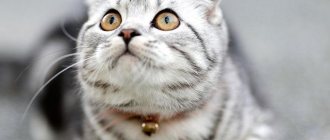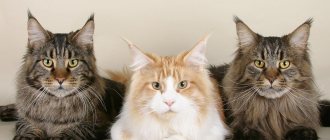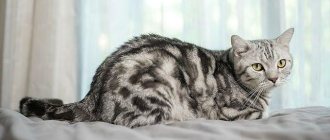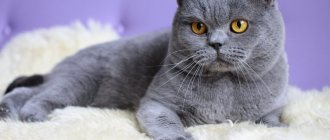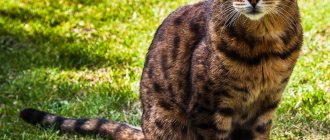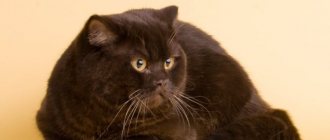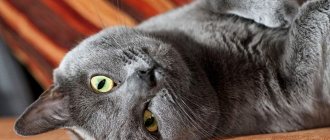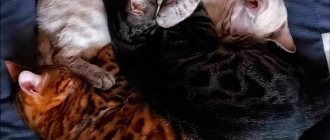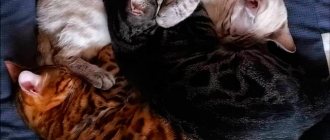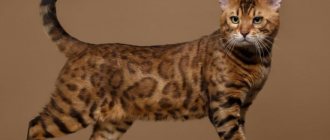Features and genetics of color
The merle is a variation of the repeatedly described tabby color. Read the article about tabby cats, there you will find information about this color and its types.
Characteristics common to all tabby colors are thin lines on the muzzle, which clearly outline the upper and lower eyelids, and form a characteristic letter “M” on the animal’s forehead. Scientists believe that the original cat species had this pattern on the skin, which is why it is often called “wild”.
When a cat's fur is in unusual patterns, that is, there are large concentric or spiral circles on the sides, 3 parallel clear stripes along the ridge line, rings on the paws and spots on the belly, the color is called marbled or classic tabby.
Features of mating marbled British
Cats in their first heat are not allowed to mate; the body is not yet ready to bear viable offspring. It is optimal to schedule the denouement for the third mating season. A partner should be selected in advance; for breeding, a candidate is sought in the club. It is advisable for a young female to be provided with a partner with experience.
Before this, both of them must be wormed two weeks in order to avoid infection of kittens with helminths during birth. The mark on comprehensive vaccination and rabies injection must be made no earlier than a month before the intended date and no later than a year. A cat's claws must be trimmed before mating.
During mating games, the female often slaps her gentleman in the face with her paw; such a preventive measure will help avoid eye injuries in case of an unsuccessful hit.
The cat is brought to the male, it is advisable to provide her with her own bowl, tray, transportation, where she can retire to rest. Some ladies need time to adapt to new conditions, but after an hour or two, instinct will prevail over caution.
Owners sometimes enter into written agreements on the temporary transfer of the animal into someone else’s hands, which also stipulates the conditions under which mating takes place (free of charge, for money, a maintenance kitten, etc.). The paper eliminates controversial issues in the future. If pregnancy does not occur, the other party should be notified.
Types of merle color
Marble color, in turn, has many varieties. First of all, it is divided into regular and tortoiseshell.
The regular one, in turn, differs in color:
- Black marble - charcoal lines on a dark brown main background. The eyes and the outline of the red-brown nose are outlined. Eyes - yellow, orange, brown.
- Chocolate marble - a pattern of dark chocolate on light. The lining is thick brown. The eyes are the same as those of a black marble, the paw pads and nose are brick-colored.
- Cinnamon marble. The background is light honey, the pattern on the fur and the lining of the nose and eyes, the paw pads are cinnamon. Eyes yellow tones.
- Red marble. Bright red pattern on a red background. The same outline and paw pads, eyes of different shades of yellow and orange.
- Cream. Very similar to red, only all the tones are gentle, muted.
- Blue. The main background is beige shades. The pattern on the coat, the lines on the muzzle, and the paw pads are blue or gray. The eyes are yellow and brown. Paw pads are dark pink.
- Lilac. The background is silver, the design, outline and nose are lavender. The paw pads are soft pink. Eyes are yellow and brown.
- Faun marble. On a pale yellow background of fur, there are fawn-colored streaks, the outlines on the muzzle and the paw pads are pink. Eyes copper, orange, brown.
Tortoiseshell marble differs from ordinary marble in that the background color has two colors:
- Black turtle - the background in this case is red and brown, and the design is black and bright copper.
- Chocolate - the background and designs of chocolate and red are mixed.
- Cinnamon has a honey and red background; the designs also differ in color saturation.
- Blue - beige and peach background with patterns.
- Lilac - lavender and peach and patterns of varying saturation.
- Faun - ivory and peach with streaks.
Tortoiseshell marble is not the prerogative of females, since there are not three colors, but usually varieties of two.
SILVER MARBLE BRITISH: PHOTOS OF CATS, CATS AND KITTENS
| In our cattery you can “buy a real British kitten.” We have many different colors, we will help you choose and answer all your questions! |
Difficulties of breeding
Since this color is recessive, two marbled parents produce exactly the same kittens. But it often forms in spotted or tabby mackerel. That is, absolutely all tabbies are carriers of the classic marble, and it is impossible to predict which pair will give birth to which kittens.
Another difficulty in obtaining marble is that the intensity of color and contrast also does not lend itself to any pattern.
Another problem is that the stripes of the pattern become too wide, covering the entire body, and the main background is visible through them in thin stripes. The animal does not lose its beauty, but by breed standards it loses. Therefore, to obtain beautiful marbled kittens, experienced breeders carefully select producers, carefully studying their pedigree.
To the exhibition with the marble Briton
Since British cats were officially recognized as a breed back in the 1980s, these purrs regularly participate in advertising shows, seminars and exhibitions. Marble Britons were no exception.
British marbled cats are regulars at exhibitions and shows
Before sending your pet to a competition, it is necessary to carry out hygiene procedures - wash the animal, clean the eyes and ears, and comb the hair thoroughly. You also need to carefully trim the tips of the claws and give the fluffy a little sedative before the trip (1-2 drops of valerian).
To participate in the exhibition you must meet a number of requirements:
- have a veterinary passport and a document about the origin of the cat;
- the animal must be completely healthy;
- Murka should not have fleas and other parasites;
- The minimum age of a cat is limited to 3 months.
The British Marble will not be allowed to compete if:
- aggressive behavior;
- deafness;
- the presence of tattoos and other interventions in appearance.
Mr. Cat Recommends: False Marble
With a tabby pattern, each hair is ticked and painted in several colors. If it is excessive, the marble pattern turns out to be shaded, as if supported by a film or fog.
This blurriness is called moiré or false marbling in the British breed.
For Bengals, this phenomenon is called phasing, and it has a different character. The ticked undercoat covers the main color, but it definitely goes through. Moreover, it is marbled kittens that flourish earlier than others - spotted, rosette.
But British moire patterns can remain “shaded” for life. No one can predict whether a baby will get ticking or not. Therefore, it is better to purchase marbled British kittens, straights or Scottish, later - by 4-6 months.
Where does the British marbled cat come from?
Since the beginning of the 20th century. British cats included not only plain blue animals, but also tabby cats with different shades on their fur coats. Thus, in 1901, American felinologists registered a Belle cat with a red tabby color.
British marbled cats appeared as a result of crossing with other breeds
The consequence of two world wars was the almost complete extermination of the British breed, so breeders began to crossbreed pets with representatives of other varieties - Burmese, Russian Blues, Persians and Scottish. The result was the appearance of many varieties of British color while simultaneously preserving the breed characteristics (wide paws, protruding cheekbones, “plush” coat).
At the same time, among all the variations of the striped coat of the British fur coat, it is the marble color that is considered classic, occurring naturally. Zoologists are inclined to believe that the symmetrical darkening on the fur of catfish from Foggy Albion is an inheritance from wild Asian or African ancestors.
Some breeds and types of marble
The merle color is found in various varieties in many domestic cat breeds.
Bengal marble
He is very unique. These hybrid cats have primary color patterns of gold, silver, snow and charcoal, but always with a tabby pattern. These can be bright spots, peculiar “rosettes” or various stains. That’s why they call marble “on gold”, “on silver”, snow and coal.
The type of pattern itself is also different. If you don’t delve into the special terminology, but accept the generally accepted one among breeders, then it can be of the “cloak” and “sparble” type.
Cloak marble is the most inexpressive pattern, when dark lines practically merge and overlap the main background. Such animals are poorly valued.
But sparbles are highly valued. These cats can be said to combine large two-color rosettes and large concentric circles on the sides, belonging to true classic marble. Usually such animals are the brightest and most expressive in the litter, with bright glitter.
Bengals do not have tortoiseshell marbles.
British marble
It is common in closely related breeds - the British and the Scots, which differ only in the shape of the ears; in the latter they are bent forward and hang down.
This is one of the oldest breeds of domestic cats in Europe. Received by crossing street, English and Persian individuals. The structure of their short, printed coat with abundant undercoat is reminiscent of teddy bears.
By nature, these animals are quite capricious, lazy, independent and picky. But with proper training, they make excellent pets.
The merle color can be regular or tortoiseshell. It is these breeds that have the greatest difficulties in breeding this color due to the moire factor.
Asian tabby
The name of the breed itself speaks about the color characteristics. Bengal wild type marbles are common. But moire is quite common, since the breed was obtained by crossing a Burmilla and an Abyssinian, which is distinguished by high ticking.
These animals are very active, playful and restless. They are extremely attached to their owner and distrustful of strangers.
American Bobtail
It is also distinguished by a variety of colors, among which marble in various color variations is not the least important.
This is an American breed, bred in the 50s of the last century. The main distinguishing feature is the short tail, which is often called a bob. The coat can be short or medium length.
Smart, sociable, independent pets are excellent companions for all household members.
Read more in the article about American Bobtails.
Bramble
This very young breed (2000) bears the name of its creator Harry Bramblett. In addition, it is also used in consonance with the English word for “thorn” - “bramble”.
Obtained by crossing a Bengal cat and a Peterbald with a brush coat. Therefore, the marble of these cats is of the Bengal type, and the fur itself resembles a hard wire in appearance, but is soft to the touch. This is currently an experimental and very rare variety.
In character they are unusually reminiscent of Bengal.
Bohemian rex
Extremely rare animals. They were bred in the 80s of the last century, but breeding work has practically ceased.
They descended from short-haired Persians with a rare gene for curly hair, apparently accidentally introduced during crossings during the selection of German Rexes.
Very cute and obedient pets come in a variety of colors, including marbled ones.
Devon Rex
Can also be marbled. It was this breed that was formed due to a random mutation.
This was discovered when an attempt was made to cross them with Cornish Rex. The genes of the two species turned out to be different; the desired result did not work out.
Like all curly-haired cats, Devon Rexes resemble in their behavior the symbiote of a monkey, a dog and a cat. Cheerful, energetic, restless pets are loving, intelligent and trusting.
Napoleon
This amazing animal only recently received the title of a provisionally recognized breed six years ago, but has won the love of the whole world due to its unusual appearance and chic character.
American breeder Joe Smith crossed Persians and Munchkins to get a long-legged variety of the latter, but the result was short-legged Persian cats that absolutely did not inherit the warlike and harmful temper of their ancestors.
The colors of the breed are varied, marbled Napoleons are one of the most beautiful cats in the world.
Other breeds
These are not all breeds, among whose representatives marble beauties are often found. These also include:
- American Shorthair and Wirehair;
American shorthair cat
- American Curl;
- Brazilian Shorthair;
- European Shorthair;
- California radiant;
- Kanaani;
- Karelian, Kuril and Japanese bobtails;
Two Karelian bobtails
- Cymric;
- Laperm;
- Lamkin;
- Munchkin;
- Manx;
- Maine Coon;
- Norwegian Longhair;
- Oriental and many others.
How to do a marble manicure
To create a marble manicure, you must first prepare the client's nails. First of all, the manicure itself is performed, edged or hardware. After this, the main color of the varnish is applied to the nail plate in two layers and dried. After drying, use a brush to carefully apply small drops of polish of different colors onto the nail. For example, black, gray, white. Using a needle or dots, mix fresh drops of varnish all over the nail, in those places where voids will form, carefully finish the design with a brush. When the varnish dries, apply topcoat, dry, and that’s it - the design is ready.
White marble manicure
The marble effect looks very beautiful and elegant in white colors. White marble is currently a trend in the nail industry. This design is suitable for every day, and even as a wedding manicure it will be excellent. For a unique design that will attract the attention of others, you can choose bright notes on white marble. White marble under a velvet covering also looks attractive. White is a classic color that will never go out of style. White goes perfectly with other colors. And of course, rhinestones, kamifubuki, foil, mica and much more will help add zest to a white marble manicure.
Recommendations for care and maintenance
The rules for caring for the coat and maintaining a marbled British or Scotsman are the same as for other representatives of the English breed.
The British and Scots are unpretentious eaters, but capricious colors sometimes react to the diet.
With the main light color of merle colors, it is not recommended to get carried away with seafood, although cats love them very much. Excess iodine immediately covers the white areas with a yellowish tint, which will disappear as soon as the menu is balanced.
Trace elements of copper give a reddish tint, and excessive consumption of poultry by-products manifests itself in the form of a gray coating on the animal’s fur coat.
